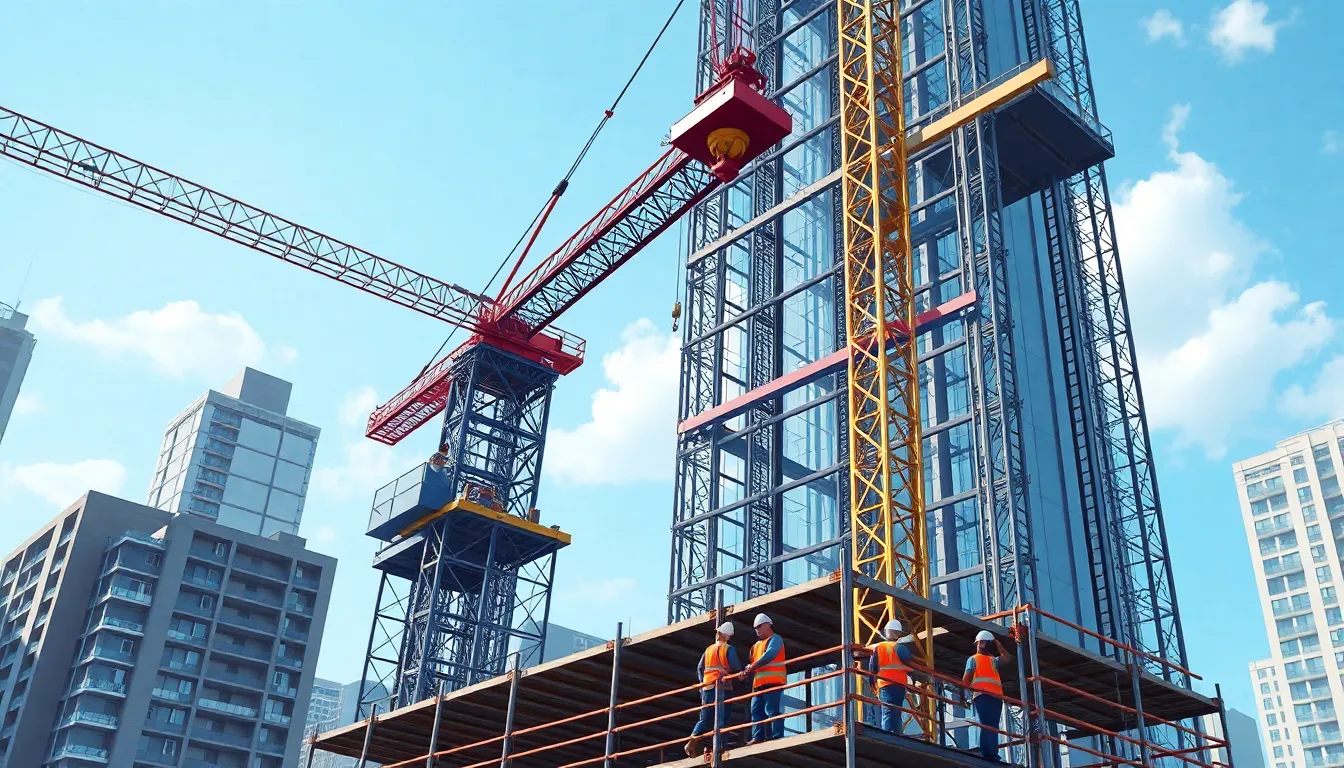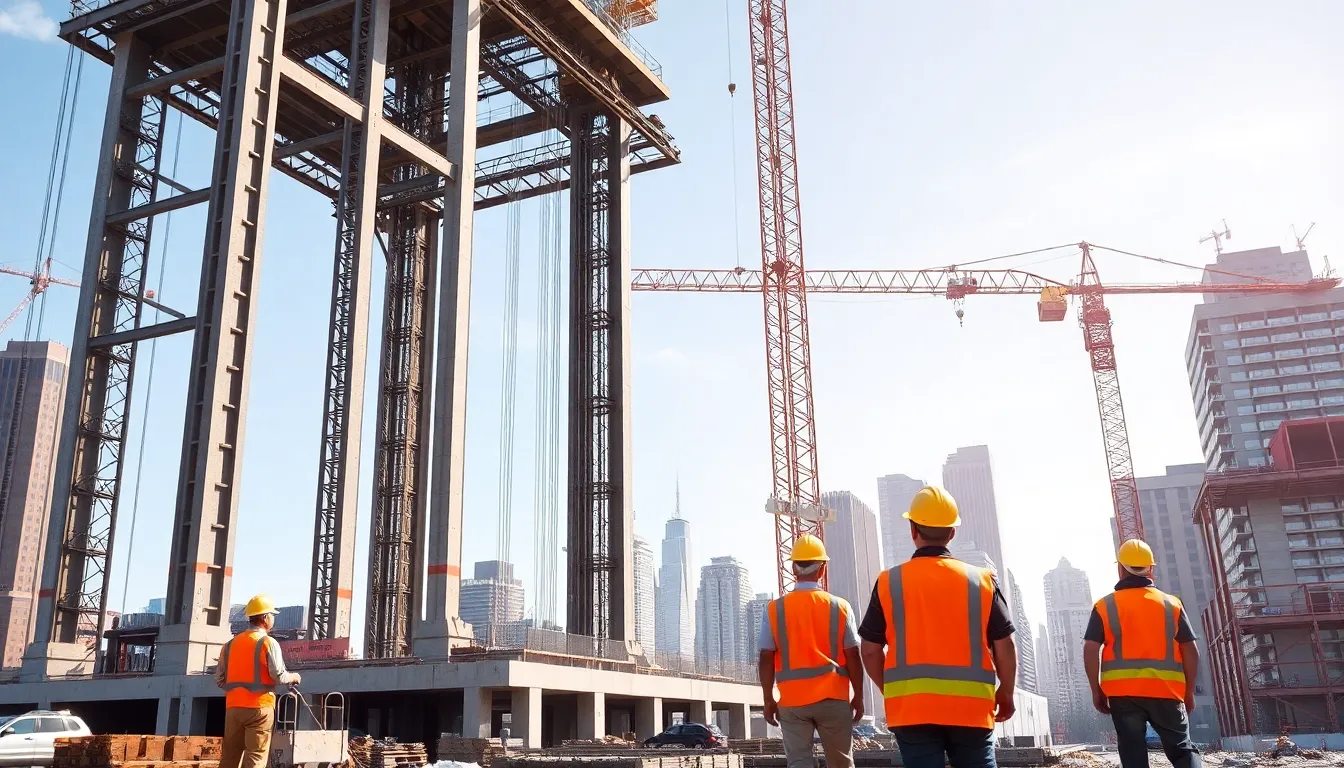In a world where urban space is as precious as gold, high-rise buildings stand tall, quite literally, as the solution to our ever-growing need for space. These architectural marvels not only redefine city skylines but also challenge the limits of engineering and creativity. Imagine living or working in a structure that kisses the clouds—it’s not just a dream; it’s a reality for many!
Table of Contents
ToggleOverview of High Rise Building Construction
High-rise building construction involves complex planning and execution. Architects and engineers work together to design structures that meet both aesthetic and functional requirements. The process begins with site analysis, which assesses soil conditions, environmental factors, and accessibility.
Innovative materials like reinforced concrete and steel are fundamental in high-rise construction. These materials provide the necessary strength to withstand wind forces and seismic activity. Building codes specifically outline safety measures, ensuring structures remain secure during extreme weather events.
Construction techniques also evolve with technology. Prefabrication and modular construction streamline processes, reducing overall time and labor costs. These methods enable quicker assembly on-site, enhancing project efficiency.
Safety management procedures play a critical role in high-rise projects. Workers undergo extensive training to handle equipment and materials safely. Utilizing scaffolding and safety gear minimizes hazards on-site, safeguarding both employees and the public.
Sustainability has become increasingly important in modern high-rise designs. Implementing energy-efficient systems, such as solar panels and green roofs, reduces environmental impact. Water conservation measures like greywater recycling can also be integrated, promoting responsible resource use.
The economic impact of high-rise construction is significant. These buildings maximize land use in urban areas, creating mixed-use developments that foster vibrant communities. Job creation during the construction phase boosts local economies, linking construction projects to broader growth initiatives.
High-rise buildings represent a blend of innovation, engineering excellence, and urban growth. As cities continue to evolve, these structures symbolize progress, offering solutions to urban challenges while enhancing city landscapes.
Key Components of High Rise Structures


High-rise buildings consist of several key components essential for their stability and functionality. Understanding these components helps grasp the complexity of high-rise construction.
Foundation Systems
Foundation systems provide essential support for high-rise structures. Deep foundations, such as pile foundations, stabilize buildings by transferring loads to bedrock or stable soil layers. Spread footings, another option, distribute weight across a broader area. Similarly, mat foundations work by creating a large concrete slab that supports the entire structure. Engineers evaluate soil conditions during the planning phase to determine the most effective foundation type. These considerations ensure structural integrity and safety against environmental forces.
Structural Systems
Structural systems form the core support frameworks of high-rise buildings. Load-bearing walls and columns help manage vertical loads, while beams support horizontal loads. Steel frames offer flexibility and strength, accommodating taller structures. Reinforced concrete provides durability and resistance to seismic activity. Architects often incorporate core systems for elevators and stairwells, enhancing the building’s overall stability. Ultimately, the choice of structural system influences a building’s design, safety, and performance in urban environments.
Design Considerations in High Rise Buildings
Design considerations play a vital role in the planning phase of high-rise buildings. Aesthetic appeal is critical for enhancing urban landscapes.
Aesthetic Factors
Architects focus on innovative design concepts to create visually striking structures. Color palettes, materials, and textures enhance the building’s appeal. Unique shapes and architectural features set the building apart, making it an iconic part of the skyline. Green spaces, balconies, and terraces can incorporate natural elements, improving livability. Thoughtful lighting also contributes to the visual impact, especially during nighttime. Ultimately, a building’s design reflects its purpose while harmonizing with surrounding structures.
Safety Regulations
Safety regulations ensure high-rise buildings adhere to strict guidelines. Local building codes dictate various safety standards, focusing on structural integrity. Wind resistance and seismic design are pivotal; engineers must consider these factors to minimize risk. Fire safety measures include installing sprinkler systems and using flame-retardant materials. Accessibility for disabled individuals is also mandated, promoting inclusivity. Regular inspections and maintenance address potential safety hazards, ensuring occupant well-being. Compliance with these regulations fosters trust among residents, employees, and visitors.
Construction Techniques and Methods
High-rise building construction employs various techniques and methods to achieve efficiency and stability. Emphasizing innovative approaches remains essential in meeting project demands.
Modular Construction
Modular construction involves prefabricating sections of a high-rise off-site. Each module is built within a controlled environment, enhancing quality control and minimizing waste. After completion, these modules are transported and assembled on-site, significantly reducing construction time. This method allows for quicker project delivery while maintaining high standards. Furthermore, modular construction increases safety since workers spend less time on-site during hazardous phases. Its adaptability makes modular construction an attractive option for urban high-rise projects, ensuring effective use of limited space.
Traditional Construction
Traditional construction refers to techniques relying on conventional materials and methods for high-rise building development. This approach typically starts with extensive site preparation and sequential construction phases. Structures often utilize reinforced concrete and steel framing to ensure durability and strength. Builders focus on achieving precise vertical alignment through careful planning and execution. Routine inspection occurs throughout construction to maintain compliance with safety regulations and quality standards. While traditional methods can extend project timelines, skilled labor and industry expertise ensure reliable results, contributing to the longevity of the structure.
Challenges in High Rise Building Construction
High-rise building construction faces numerous challenges that can impact the project’s success. Addressing these challenges requires careful planning and execution.
Environmental Impacts
High-rise buildings significantly affect local ecosystems. Construction processes often involve substantial land disruption, leading to habitat loss for various species. Additionally, high energy consumption during construction and operation can contribute to air and water pollution. Noise pollution poses another challenge, impacting nearby communities. Implementing sustainable practices, like green roofs and water recycling systems, can mitigate these effects, ensuring environmental responsibility during and after construction.
Time Constraints
Time constraints play a critical role in high-rise construction projects. Tight schedules arise from the high demand for urban space, leading to intensive project timelines. Delays can result from various factors, such as adverse weather, supply chain issues, or permitting challenges. Quick decision-making is essential to stay on track. Efficient project management strategies, including advanced planning and clear communication among stakeholders, help keep the project within its deadline. Balancing quality and speed remains vital for successful high-rise construction in today’s fast-paced urban environment.





